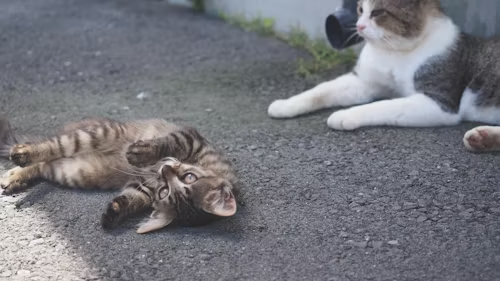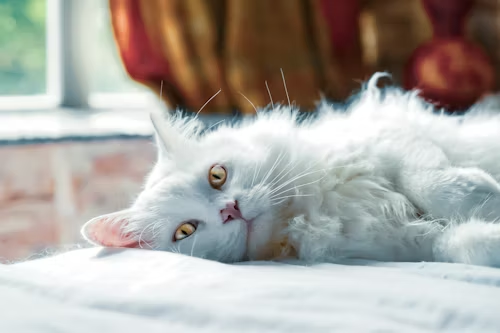Some cats just love rolling on the floor—especially when there’s dirt or sand around. The moment they spot a dusty patch, they’ll happily flop down and start wriggling and rolling like they’re having the time of their lives.But why exactly do cats enjoy rolling around on the ground so much?Let’s take a closer look today and uncover the reasons behind this quirky feline behavior!
1. Showing Affection and Trust
One of the most common reasons your cat might suddenly roll on the floor—especially when it sees you—is to express love and affection. Just like humans hug or kiss to show emotion, cats roll around to share their excitement and warmth.When a cat rolls over, it may twist its body and even expose its soft, vulnerable belly. This is a powerful sign of trust. A cat’s belly is one of the most sensitive and defenseless parts of its body, so when your feline friend willingly shows it to you, it means they feel safe, relaxed, and deeply trust you.For example, when you return home after a long day at work and your cat runs up and starts rolling around your feet—it’s their enthusiastic way of welcoming you back and saying, “I missed you!” Gently petting them or scratching their tummy at that moment will not only make them happy but also strengthen the emotional bond between you.
2. Getting Ready to Hunt
Cats are natural-born hunters. Even though your kitty may live a comfy indoor life, its hunting instincts are always present. When your cat sees something that reminds it of prey—like a feather toy or a bug crawling in the yard—it may roll on the ground in preparation.This isn’t just playful behavior. Rolling helps the cat stretch, loosen its muscles, and align its body in a ready position to pounce. It’s part of their warm-up routine before going into “hunt mode.” So next time your cat rolls before leaping, remember—it’s sharpening those stealth skills!
3. Marking Their Territory
Cats are territorial animals, and one way they claim space is by marking it with their scent. Rolling on the ground is one such method. This instinctual behavior has roots in the wild, where scent-marking helps cats establish boundaries, protect resources, and avoid conflicts with other animals.When your cat rolls on a particular spot, it’s rubbing its scent glands (located on its head, sides, and tail base) against the floor to leave a personal scent trail. This invisible “flag” tells other cats, “This space is mine.”And if your cat rolls on the ground in front of you, it’s not just marking territory—it’s also inviting you in. It’s a unique way of saying, “This is my home, but you’re welcome here too.” A furry little show of love and ownership, all in one adorable act.

4. Rolling Could Signal Discomfort
Not all rolling behavior is positive—sometimes, it could be a sign that your cat is experiencing physical discomfort or irritation. Let’s look at a few common causes:
①Internal Parasites
Worms like tapeworms can live inside a cat’s intestines. These parasites often release eggs or cause movement in the digestive tract that irritates the area around the cat’s anus. This irritation can make your cat feel itchy or uncomfortable, prompting it to scoot its bottom or roll around on flat surfaces like floors or carpets to relieve the itch.What’s tricky is that internal parasites aren’t always visible. Even if you don’t see worms in your cat’s stool, you can’t completely rule out the possibility. That’s why it’s important to watch for subtle behavioral signs—like frequent rolling or butt-scooting—and schedule regular deworming checkups.
②External Parasites
Fleas and ticks are common external parasites that can cause intense itching. Fleas, in particular, are small and often hide deep within your cat’s fur, making them hard to spot. But their bites, movement, and feeding habits can cause all-over itchiness—especially around the tail and anal area.Ticks, which attach themselves to your cat’s skin, can also cause pain and irritation. Your cat may roll its body or rub against surfaces in an attempt to get rid of them. If your cat is rolling more than usual and seems restless, check for signs of fleas or ticks, especially if you’ve been outdoors recently.
③ Anal Gland Blockage
Cats have anal glands located on either side of their anus. Normally, these glands express themselves naturally during defecation. But if they become blocked, fluid can build up inside, leading to swelling, discomfort, and even infection.A cat with impacted anal glands may try to relieve the pressure by dragging or rolling its lower body on the floor. This motion helps stimulate the glands and may offer temporary relief. If your cat frequently scoots or seems obsessed with its back end, it might be time for a vet visit to check for anal gland issues.
④Dirty Fur Around the Rear
For long-haired cats, fur around the tail and rear end can easily pick up debris like feces, litter, or other messes. This buildup can cause irritation and even increase the risk of skin inflammation.If your cat is rolling on the floor or rubbing its backside, it might be trying to remove stuck-on dirt or waste. Regular grooming, especially for long-haired breeds, can help prevent this problem and keep your cat comfortable and clean.
⑤ Diarrhea Discomfort
Diarrhea, regardless of the cause—parasites, food intolerance, or gastrointestinal infection—can leave the skin around the anus sore and sensitive. Even after using the litter box, cats may feel lingering irritation.As a result, your cat may roll around or scoot in an effort to soothe the discomfort. Pay attention if your cat’s rolling behavior increases after a bout of diarrhea, and monitor other symptoms like appetite, hydration, and energy levels to determine if medical attention is needed.

5. Rolling as a Sign of Affection
Beyond the medical or physical reasons, rolling can also be your cat’s unique way of showing affection. When your cat wants your attention or a little extra love, it might flop onto the floor and start rolling around, belly up, as if performing a cute little show just for you.This behavior is usually accompanied by soft purring, which is your cat’s way of saying, “Notice me! Let’s play or cuddle!” It’s a social and emotional gesture that reflects trust, comfort, and the desire to bond. If your cat rolls at your feet and makes eye contact, it’s likely hoping you’ll respond with pets or praise.
6. Rolling as a Sign of Being in Heat
When a female cat is in heat, rolling on the floor is a common behavior triggered by hormonal changes. These changes can make her feel restless and more affectionate than usual.A queen in heat may roll frequently, raise her tail, rub against furniture or people, and vocalize loudly with yowling or meowing. These behaviors are all part of her natural instinct to signal to male cats that she’s ready to mate.Male cats, on the other hand, may respond by spraying urine to mark territory and attract females, especially if they detect pheromones in the environment.If you’re not planning to breed your cat, it’s strongly recommended to spay or neuter your pet at the appropriate age. Not only does this help prevent unwanted litters, but it also reduces stress-related behaviors and makes your cat more relaxed and easier to care for during mating seasons.
Alright, that’s all for today’s article!There are many reasons why your cat might enjoy rolling on the floor—it could be emotional, instinctive, or even related to health.However, if you notice that your cat’s rolling behavior is accompanied by unusual symptoms—such as skin redness or swelling, excessive vocalization, loss of appetite, or if there is a sudden and dramatic change in behavior—it’s best to consult a veterinarian promptly.A thorough check-up can help determine whether there’s an underlying medical issue that needs attention. Your cat’s well-being is always worth the extra care.

